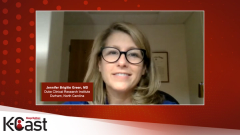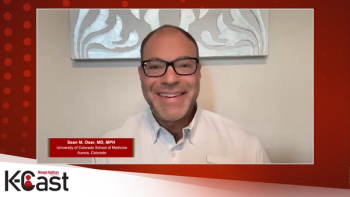
Advantages of Using Fixed-Ratio Combinations in Type 2 Diabetes
Rodolfo J. Galindo, MD, comments on the benefits of fixed-ratio combination therapies for the management of type 2 diabetes compared with premixed insulin.
Episodes in this series

Rodolfo J. Galindo, MD: I would like to discuss with the audience a clinical scenario that we see very often in our practices, and it’s very interesting. Many of our patients with type 2 diabetes are treated with premixed insulin. Many years ago, in the 1990s, smart doctors who I have had the pleasure to know, such as Philip Raskin, MD, from UT [University of Texas] Southwestern, were working on combining 2 types of insulin—intermediate-acting insulin, so called NPH [neutral protamine hagedorn], and short-acting insulin, regular—because it makes sense. I discussed earlier the combination of basal plus GLP-1 [glucagon-like peptide-1]. Many years ago when we didn’t have GLP-1 with its wondrous actions, the thinking was, let’s combine intermediate insulin that would act as a basal insulin with a short-acting insulin that would treat the postprandial glucose excursion, which I mentioned happens and is not controlled by basal insulin. That was developed many years ago, and of course, when you combine it, it gives you good results but also many other undesired effects. Commonly, you get hypoglycemia, and it’s really hard to control that postprandial spike with the premixed insulin. It’s designed for that, but it actually does not achieve that goal as the combination of basal and GLP-1 does.
Many of our patients are treated with that combination of premixed insulin mainly because of cost, and I would say even more for access. Many of the insurance plans and the coverage are very friendly with premixed insulin and less friendly with the newer agents. The reality is that maybe cost is not the best factor to consider because you have a combination medication now that has a lower price, but long term you get patient complications, and you don’t achieve [the target] A1C [glycated hemoglobin]. In one or two years, you might not get that result and that lower cost that you’re seeing every month. You need to have a long-term perspective on that aspect. Many of our patients, unfortunately, are still treated with premixed insulin, mostly because of access and cost.
The iGlarLixi [insulin glargine, lixisenatide] team decided to do a study and compare iGlarLixi with premixed insulin. Again, combining glargine with lixisenatide was compared to premixed insulin, and I think it was really needed. For many years, I’ve been trying to use a more physiologic and more friendly approach to treating type 2 diabetes, combining agents with complementary actions. But I’m a specialist in diabetes, so I want everybody else to know that there are other ways to do it as well, not just for specialists. It was known to me that this combination of premixed insulin was not treating my patients well, but the data needed to come, and those were the data that were done. The study was published by Julio Rosenstock, MD, a good colleague from UT Southwestern and Dallas Diabetes Research Center. It was an international study and took patients who were not controlled on basal insulin therapy and oral agents. Basically, they were taking basal insulin and the oral agents were there to control this postprandial glucose excursion that I mentioned that we need to control, because the 2 components will lower the A1C. It was an open randomized trial, and they had an A1C inclusion of 7.5% to 10%, again, very uncontrolled patients.
One point that I want to make, always keep in mind what is important to your patients. Premixed insulin, you need to take it twice a day minimum, and the fixed-ratio combination is once a day, so at least you’re getting away from 1 injection, which is really important to our patients. Remember burden: burden of care, amount of work, amount of diabetes injections, number of finger sticks, and all of that. It’s important to decrease and minimize the burden. This study was published in Diabetes Care in 2021. When you compared iGlarLixi with premixed insulin in patients who were uncontrolled on basal insulin and oral therapy, there was a higher A1C reduction in the group with iGlarLixi. And more importantly, and I explained this before, patients lost more weight, approximately 1.9 kg. That’s about 5 lb of weight loss, and of course, some patients lost more, versus patients that were treated with premixed, who tended to gain weight. But more importantly, and I think this is also very important for patients and especially for me as a clinician, they had less hypoglycemia. Again, you can control the A1C, you can increase the insulin, but if you’re getting hypoglycemia, then you’re not really helping your patient. You’re putting them into treatment-related complications that don’t need to happen because there are newer agents with safer profiles. And of course, more patients achieved that composite A1C of less than 7%, with the weight targets.
It was very interesting to see this, that an old therapy that was conceived as a more accessible therapy was not better than this newer, simpler, once-a-day fixed-ratio combination of iGlarLixi. And we were very excited. I see many patients with managed care, and this is typically the case. Many of the managed care companies try to be very open to covering premixed insulin, and I guess it’s because of cost. The reality is that you may be getting better A1C reduction and lower cost, month to month, but when you put that on the long term, you may be getting more complications. Some patients are having more hypoglycemia and gaining weight. The adherence and the persistence and the continuation of therapy may not be the best. It’s very important that our patients know this, our clinicians, but also our colleagues from managed care, and health systems, and insurance companies, that they understand these points. Because it’s not just what happened this month, it is what will happen in the longer run.
Transcript Edited for Clarity
Newsletter
Get the latest industry news, event updates, and more from Managed healthcare Executive.















































